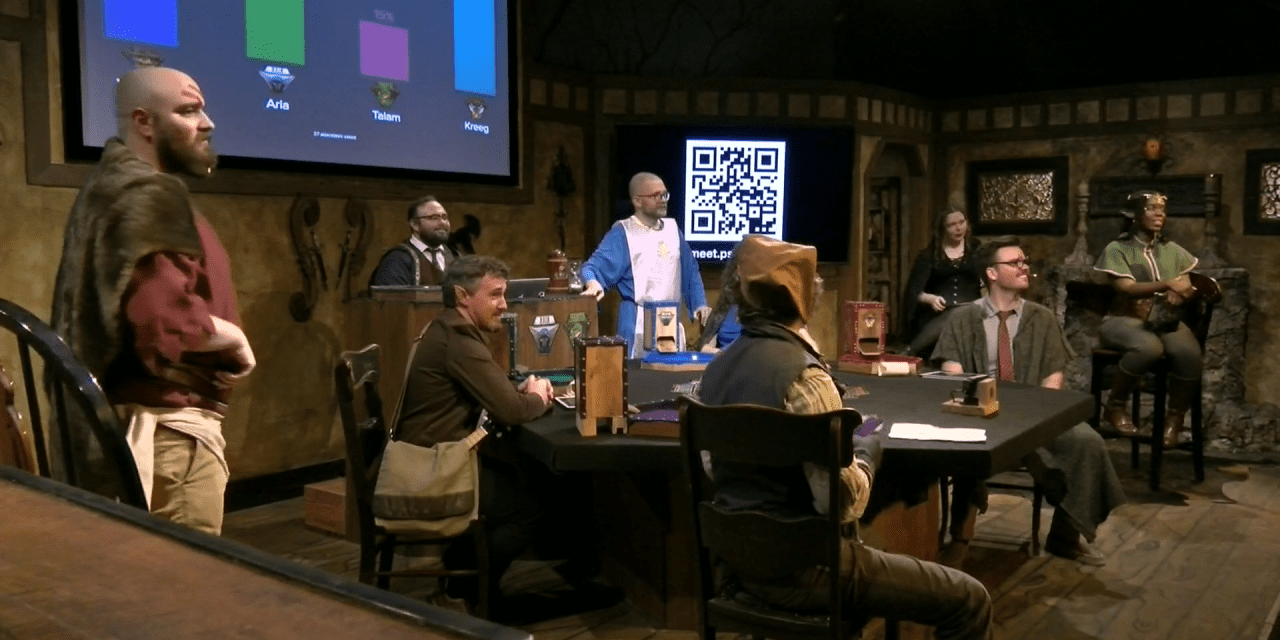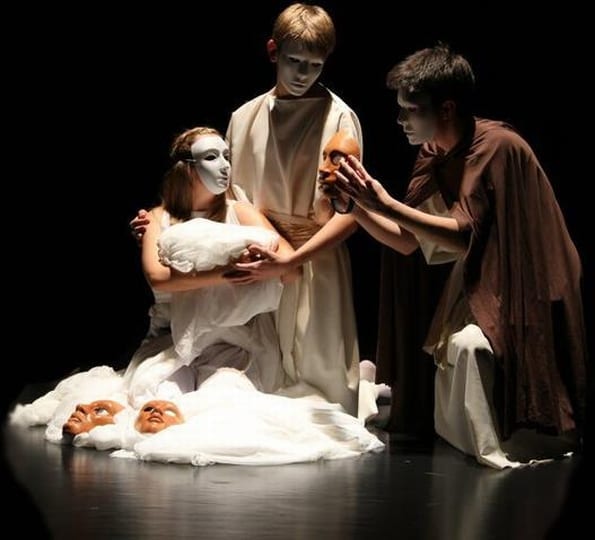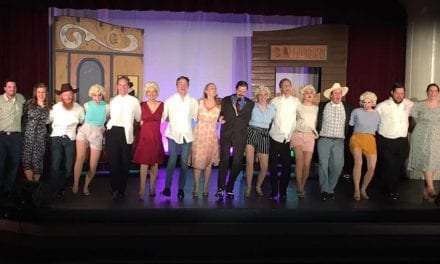PROVO — The Hive Collaborative is a new theatrical facility built last year in Provo. According to producer Dennis Agle, the locale was created “with the idea that it would be a space for creating works that were off the beaten path, but would still be something that might resonate with Utah County audiences.” My first experience at the Hive watching the season finale of the role-playing tabletop game series Enter the Hex proved to be just that — unusual, yet unexpectedly entertaining.

Show closed May 11, 2019.
Readers must understand that this is not your typical play; though there was a stage with a beautiful, intricate set (designed by Ken Agle), elaborate costume and makeup design (by Sierra Crawford and Shelby Gist, respectively), and talented actors that kept the crowd laughing and cheering, the night produced more than the typical theatrical piece. What the Hive Collaborative created was a fascinating combination of a board game, improv comedy performance, and a live televised game show. I attended an evening with both the 19th and 20th chapters of the characters’ stories as they played a unique version of the wildly popular Dungeons and Dragons gaming phenomenon.
From a theatrical standpoint, many things were done right. Beginning with the set, Ken Agle created an elaborate medieval tavern that was absolutely magnificent. From the bartender’s area to the cozy fireplace with realistic burning logs at the opposite end, the charm was found in the details. The set had a symmetry that focused on a large projector screen at the center, which helped the audience to both visualize and understand what was happening in the players’ game. The surrounding wall was ornamented with opposite facing axes, swords, and mirrors that directed viewers’ eyes to the main event. Beneath the screen was a large, hexagon-shaped table with a place for four game players to sit, and a narrator at the head of the game playing area. Chairs around the tavern occupied by “champions” completed the symmetrical look of the set.

Josianne Petit as Orchid Wraithclaw, Guardian of Clan Talam.
With the setting clear, the improv actors who would play this game entered the tavern (called “The Hex”) in impressive costumes that accentuated the dispositions and backgrounds of their characters. Robes, capes, eye patches, and boots placed these characters in a medieval time period. Each player of the game belonged to a team, and the pairs of team members matched in both color and costume design. Crawford made it easy to identify who was who among the ten onstage performers.
Gist’s hair and makeup turned the actors into something fantastical out of an imaginary medieval world. Elf ears and bright colored face paints transported viewers into the mystical realm where the game would take place. Of special note was the character Orchid Wraithclaw, the Guardian of Clan Talam, whose long hair was adorned with golden beads and a beautiful matching headpiece, elf ears showing through the hair. This, accompanied by facial highlights in gold paint, turned actress Josianne Petit into a truly magnificent “guardian.” It was obvious that Gist and Crawford paid attention to each character, providing context for the story through the appearances of the cast.

Patrick Newman as Galavor the Hexmaster.
There was an obvious variety in the acting experience of each performer in the cast. However, the innovative idea of the entire show allowed the otherwise underqualified to flourish in an unusual and distinctive space. Will McAllister played Helmer, Champion of Clan Kreeg. He was one of the funniest members of the cast, remaining in character even during intermission. McAllister spoke exclusively in the third person, and had a few noticeable twitches befitting of the champion he portrayed. He was constantly snacking on something in his bag, and his body language made it clear that he was very protective of its contents. Though McAllister played a relatively minor role the evening I attended, his acting skills were above par.
Stephen Newman was another talented actor who sat at the hexagonal table to play the game. He played the somewhat pious character of Father Benedict, Guardian of Clan Aria. Newman excelled in keeping his accent through each activity, and always paired his “moves” in the game with humorous commentary that kept the crowd rolling with laughter. Speaking to an imaginative, giant blue worm, he exclaimed, “I suggest you crawl back down whatever hole you come from!” and then proceeded to announce his game plan, which resulted in cheers and friendly banter and guffaws from the entire audience.
In an effort to avoid rambling on forever, other noteworthy performers include the unabashed Michael MacEllen Comp, who played Madison D¹Lour, Guardian of Clan Veneda; she was very comfortable on stage and constantly prepared with a witty comment. The musically talented Mike McClellan also warrants mentioning. Playing the character Niko, Champion of Clan Talam, McClellan sang all of his lines to the tune of his own ukulele.
Coupled with these talented performers were first-rate producers and directors. Ken Agle, Dennis Agle, and Patrick Newman did an incredible job of filling the stage with content, embracing the idea that this show was not just for Dungeons and Dragons experts. The three incorporated “challenges” that were not originally a part of the board game, but that furthered along the story (the narrative and scenarios written by Patrick Newman, Phil Schwartz, Aria Schwartz, Nate Schwartz, and Davis Agle). These challenges were very reminiscent of Minute to Win It games, camouflaged by medieval and fantasy-themed props and jargon that stayed true to the spirit of the narrative as a whole. Additionally, those who attending the live recording of “Enter the Hex” had the uncommon opportunity to participate in the game by voting on their cell phones, helping to determine the outcome of the theatrical tale.

An overhead view of gameplay during Enter the Hex.
Because the performance was also live streamed, I was surprised by the high production quality at the Hive Collaborative. Having some television experience myself with PBS and BYUtv, I feel compelled to add my thoughts on this unique aspect of the production. Two floor cameras on tracks were controlled by camera operators, and a robocam got shots from above the audience and the game being played on the table, controlled presumably by technical director Chris Peck or other crew members. A good mix of wide and medium shots were taken, though close ups seemed few and far between; additional close up shots on the details of the set and scenery as well as the facial expressions of game participants would add greater variety for the at-home viewer.
Coined “gameprov” by the show’s creators, this radically fun and engaging spectacle was unique. Using a game with an already zealous following by a very niche group, the Hive Collaborative has created an opportunity for more mainstream audiences to appreciate this fantasy, role-play sensation. An overall feeling of camaraderie was created among the performers and live audience. Enter the Hex is a fantastic example of a production that models friendly competition and good sportsmanship, all the while holding the attention of a broad range of individuals and personalities, a difficult feat to say the least.
As the Hive Collaborative prepares for the second season of Enter the Hex that will materialize later this summer, the I applaud the Hive’s efforts to put together something completely out of the ordinary and uniquely extraordinary.
[/box]Enter the Hex has concluded its first season at The Hive Collaborative (591 South 300 West, Provo), which can be viewed free online at www.hivechannel5.com. To learn more about future installments of the series, including prices and dates, visit their thehivecollaborative.com.[/box]





